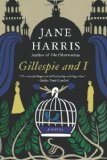Summary | Excerpt | Reading Guide | Reviews | Beyond the book | Read-Alikes | Genres & Themes | Author Bio

A Novel
by Bernie McGillI know there are many readers like me out there who will gobble up any story about a stately Victorian home with plenty of upstairs/downstairs class tension. I've tasted books like The Butterfly Cabinet before, and I still find them as alluring as toast and tea - good enough to be a regular part of the diet. And while the UK edition of the novel has a butterfly on the cover, it's no accident that the US edition appeals to readers with an aged stone house, spooky windows, and a jagged roofline; ancestral piles on this side of the pond just don't have the same patina. There are intriguing characters on both sides of the divide in Bernie McGill's Oranmore house, and the story provides readers the Victoriana they crave: there is social conservatism and florid wallpaper; there are shocking, outmoded ideas about child rearing. There are corsets.
McGill bases the story on real events that took place in the coastal village in Northern Ireland where she lives. Her Harriet Ormond is a fictionalized version of a noblewoman, Annie Montagu, who was implicated in the death of her child and brought to trial in a nineteenth-century media uproar. The events at the heart of the novel transpire in 1892, but McGill allows the narrative to accrue in small fragments told partly through Harriet's prison diary entries, and partly through the reminiscences of the former nanny of the house, Maddie McGlade, who is now in her nineties and living out her days in the "Oranmore Nursing Home".
There is something breathtaking about revisiting Victorian memories from the vantage of the modern world - the cultural shifts that happened in nanny Maddie McGlade's lifetime are astonishing to imagine. A person could be born in the impossibly distant servant-and-corset era, and still be in possession of her mental faculties in 1968, the year Hair opened on Broadway.
Many of McGill's metaphorical devices have been used before to portray the lives of women in the nineteenth century. Take the wallpaper. Charlotte Perkins Gilman's "The Yellow Wallpaper" - a story in which one woman's depression and eventual descent into madness is depicted through hallucinations seen in the wallpaper - was published in 1892, the same year Harriet writes about her interior decorating choices:
"I ordered a Morris wallpaper... an extraordinary design of white dove and gilt cage with a background so dark as to be almost black. Unexpectedly, when it arrived and was pasted on the sitting room wall and the light caught it near the window, the narrow bars of the cage all but disappeared, leaving only the gilt base and the bird apparently freed, about to take flight, while in the darker corners of the room the flickering firelight picked out the gilt and showed the bird to be exquisitely caged."
The fraught wallpaper may be unsubtle, but it's still lovely. I admit I was less taken with the butterfly cabinet analogy, which seems tired to me; beautiful, free, delicate creatures are caught and displayed on pins in a dusty box. I get it. The writing is lyrical and beguiling, but McGill can get heavy handed as she drives her butterfly symbolism home, even having Harriet's diary turn up behind a drawer in the eponymous cabinet.
The freshest and most original parts of the book have to do with motherhood, the fierceness of mother love, and the savagery society displays when it calls a failed mother to task. Harriet Ormond is a finely drawn, complex character, and her musings on the dark difficulties of being a mother are some of the best I've read anywhere:
"I am unusual among my peers," she writes in her diary, "but I have wanted, always, to be available to the children and to do what was correct... There were days, though, when the burden of what that entailed weighed on me like a blanket, and I felt like I would never get through."
And though the story involves the death of a child, it is not graphic or exploitative - rather, The Butterfly Cabinet is a long meditation on grief and responsibility.
![]() This review was originally published in The BookBrowse Review in September 2011, and has been updated for the
May 2012 edition.
Click here to go to this issue.
This review was originally published in The BookBrowse Review in September 2011, and has been updated for the
May 2012 edition.
Click here to go to this issue.

If you liked The Butterfly Cabinet, try these:

by Jane Harris
Published 2012
From the Orange Prize-nominated author of The Observations comes a beautifully conjured and wickedly sharp tale of art and deception in nineteenth-century Scotland.

by Dominic Smith
Published 2011
From the award-winning author of The Mercury Visions of Louis Daguerre and The Beautiful Miscellaneous comes a sweeping historical novel set amid the skyscrapers of 1890s Chicago and the far-flung islands of the South Pacific.
Your guide toexceptional books
BookBrowse seeks out and recommends the best in contemporary fiction and nonfiction—books that not only engage and entertain but also deepen our understanding of ourselves and the world around us.